Visit Milan in 2 days
18 must-see POIs, optimized routes and anecdotes.
Loading map...
You will visit the most beautiful points of interest in Milan



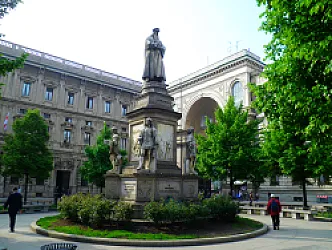
.jpg/320px-Milano_-_Monumento_Missori_(cropped).jpg)



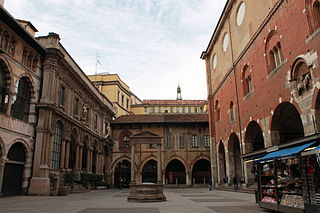








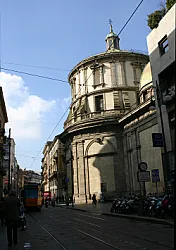
2 Days in Milan — A Compact Love Letter to Style, History, and Espresso
Milan grabbed my heart the moment sunlight spilled through the glass roof of the Galleria Vittorio Emanuele II. This city, often called the fashion capital, moves with a confident, quiet swagger. Some say it's overrated, but for me Milan's magic is in the small, lived-in moments. I wandered under arcades, sipped a bitter espresso at a corner bar, and felt instantly at home.
Why visit? Because Milan blends polished modernity with layered history in a way few cities can. It's not just about the headline sights. You’ll stroll from the shimmering Galleria Vittorio Emanuele II to the solemn grace of the Royal Palace of Milan. House Manzoni whispers literary history, while Piazza Cordusio and Piazza degli Affari pulse with urban life. Expect to hear tram bells, smell roasting coffee, and see tailored coats brushing past centuries-old stone. The feeling is elegant, unexpected, and warmly human.
Planning a trip can feel overwhelming. There is so much to see you could happily spend weeks here. If this is your first time in Milan, you might worry about missing the highlights. I get that. That’s why this Milan itinerary is focused, friendly, and realistic. Below I'll show you exactly how to spend 2 days in Milan to catch the city's essential rhythms and its hidden soul. You’ll cover key museums, grand squares, and a few secret corners that locals love.
One crucial tip before we begin: start your days early to beat the crowds and watch the city wake up. Early mornings are when the light on the cathedral is pure and the arcades feel like they belong to you. It also gives you breathing room to linger over an aperitivo later. This small habit changes everything about how you experience Milan.
Ready to find out what to see in Milan and fall in love with its contradictions? Now let's dive into the itinerary!

Quick Mini Guide to Milan
Where to stay:
- Duomo/Galleria — central, walking distance to Royal Palace and Galleria Vittorio Emanuele II; best for first-time 2‑day visits.
- Brera — artsy, great for aperitivo and proximity to Casa Manzoni and boutique shops.
- Navigli — evening atmosphere for canals and Mates, Mess and Madness MILAN tour departures.
When to visit:
- Spring or early autumn — mild weather for terraces (Duomo rooftop) and canal strolls.
- Aperitivo hours (18:00–21:00) are essential — local life peaks then in Brera/Navigli.
- Buy timed-entry for Duomo terraces and Royal Palace exhibits to skip long lines.
Things to do (2‑day plan):
- Day 1: Duomo, Galleria Vittorio Emanuele II, Royal Palace exhibition; quick walk to Piazza Cordusio and Piazza degli Affari to see the financial palazzi.
- Day 2: Casa Manzoni visit, Brera streets and Pinacoteca, afternoon Navigli canal walk and aperitivo.
- Book interactive tours: Secrets of Milan for hidden-history stories; Mates, Mess and Madness MILAN for offbeat, social evening insights.
Don't forget:
- Reserve tickets for Duomo terraces and Royal Palace in advance.
- Try risotto alla Milanese or cotoletta; enjoy an aperitivo instead of a full pre-dinner meal.
- Carry a small umbrella — sudden showers happen even in spring.
Day 1 - Milan
10 POIs to discoverDay 1 - Morning à Milan
5 Points of interest - Duration : 2h45 - Distance : 2 km - Walking : 0h27
University of Milan
- It is a member of the League of European Research Universities (LERU) and it is considered the first university in Italy and the seventh in Europe according to The Leiden Ranking.
- The university is composed of eight faculties and two schools, offering a wide variety of study programs, including areas such as Political Science, Economics, Computer Science and Law.
- It maintains more than 400 international academic and scientific collaboration agreements, including agreements with New Zealand and France.
- The University of Milan has had members awarded European Research Council (ERC) grants.
- It has a rich artistic and cultural heritage, with historic buildings in the center of Milan and modern facilities in Città Studi.
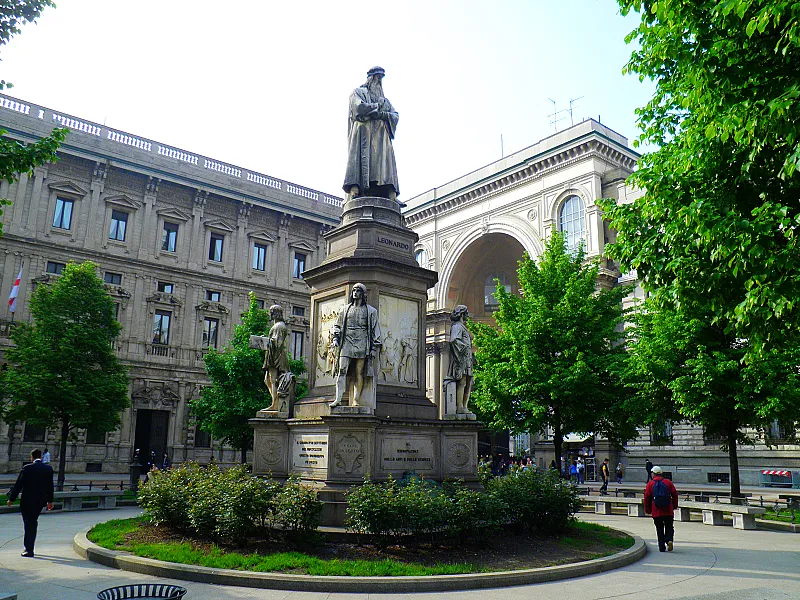
Monument to Leonardo da Vinci
- The monument was unveiled in 1872 and pays homage to the Renaissance genius Leonardo da Vinci.
- The central statue depicts Leonardo with a pen and parchment.
- It was designed by Pietro Magni, a prominent Italian sculptor of the 19th century.
- In the vicinity of the square in which the statue is located is the Alla Scala Theater and other landmarks.

San Fedele Church
- The Church of San Fedele in Milan was built in the 16th century by order of Saint Carlo Borromeo to house the Jesuits, and it reflects the architectural preferences of the Counter-Reformation.
- The church's design is believed to have been instituted over a pre-existing sacred building named Santa Maria in Solariolo.
- San Fedele is an important architectural model since it reflects a wide range of architectural designs from the past, and several subsequent churches have drawn inspiration from it.
- The structure was assigned to the Jesuits in 1567 who undertook the task of restoration and enlargement of the church.
- The chiesa di San Fedele suffered serious damage during an April 16, 1943 bombing, after which it was restored and returned to the Jesuits in 1945.⏳Although the church was completed in large part by 1579, construction of the remaining parts was carried out by other renowned architects such as Martino Bassi and Francesco Maria Richini in the subsequent centuries.
Palazzo del Capitano di Giustizia
- This palace was built in the 13th century.
- It served as the residence of the Captains of Justice of Milan.
- It features Gothic and Renaissance architecture.
- Its beautiful arcades and architectural details stand out.
- Nowadays, this building houses the headquarters of some municipal institutions.
.jpg)
Monument to Giuseppe Missori
- The monument to Giuseppe Missori is a bronze sculpture.
- The statue was made by Riccardo Ripamonti (1849-1930).
- The bronze for making it, from old cannons, was given for free by the government.
- The plate on the front tells a story from the Battle of Milazzo cited from Giuseppe Garibaldi's memoirs.
- This monument was inaugurated on May 7, 1916.
- The monument, depicting Missori on his horse, attracted attention for the unusual pose of the horse.
Day 1 - Afternoon à Milan
5 Points of interest - Duration : 3h30 - Distance : 1.1 km - Walking : 0h15San Gottardo in Corte Church
- The building was constructed from 1330 to 1336 by order of Azzon Visconti, and the ducal chapel was designed by architect Francesco Pecoraro.
- Originally, the church was dedicated to the Virgin, but later, Azzon Visconti, who suffered from gout, dedicated it to Gothard of Hildesheim, the patron saint of victims of this disease.
- The interior of the church was restored in neoclassical times by Giocondo Albertolli, with works of art such as the Giotto's Crucifixion, a canvas depicting aSt.
- Charles Borromeo by Giovanni Battista Crespi, and the tomb of Azzone Visconti.
Monument to Vittorio Emanuele II
- It was created in 1879-1896 by Ercole Rosa.It is located in Piazza Duomo, Milan, Italy.
- It is made of bronze (statue and high reliefs), carrara marble and granite (base).
- It measures 1480 cm.

Cathedral of Milan
- Construction began in 1386 and was considered complete in 1965, although some blocks remained unsculpted.
- Several stages of construction involved French and Italian architects.
- The facade combines Gothic and Renaissance elements.
- The "Madonnina" spire was raised in 1762, with a statue of the Virgin Mary. Leonardo da Vinci influenced the design of the dome.
- Napoleon Bonaparte financed the completion of the facade in 1805.

Museo del Novecento
- Exhibits nearly 400 predominantly Italian works of art from the 20th century.
- The collection focuses on 20th-century Italian artists, including Futurists such as Giacomo Balla and Umberto Boccioni.
- It also features works by individual artists such as de Chirico, Lucio Fontana, and Morandi, as well as 20th-century art movements such as abstractionism and Arte Povera.
- It has received significant donations, including works by artists such as Andy Warhol and Roy Lichtenstein.
- Among the museum's notable works are Giuseppe Pellizza's "Il Quarto Stato" and Giacomo Bella's "Ragazza che corre sul balcone.".
San Carlo al Corso Church
- The current building was built to replace the medieval church of Santa Maria dei Servi and displays a neoclassical style inspired by the Pantheon in Rome.
- The construction of the basilica took place between 1832 and 1847 under the direction of architects Carlo Amati and Filippo Pizzagalli.
- The church is dedicated to St.
- Charles Borromeo and was erected as thanksgiving for the cessation of a cholera epidemic in the region.
- The high altar houses a wooden crucifixion by Pompeo Marchesi, and altarpieces by renowned artists are preserved in the adjacent convent.
- It also houses a library in its right portico and an organ in the left choir of the presbytery.
Day 2 - Milan
8 POIs to discoverDay 2 - Morning à Milan
5 Points of interest - Duration : 3h30 - Distance : 1.6 km - Walking : 0h21
Teatro dal Verme
- Designed by Giuseppe Pestagalli and commissioned by Count Francesco Dal Verme.
- Used mainly for theater plays and opera in the 19th and early 20th centuries.
- Currently used as a concert, theater and dance hall, as well as for exhibitions and conferences.
- It originally had 3000 seats and a large dome.
- Opened on September 14, 1872 with a production of Meyerbeer's "Les Huguenots.".
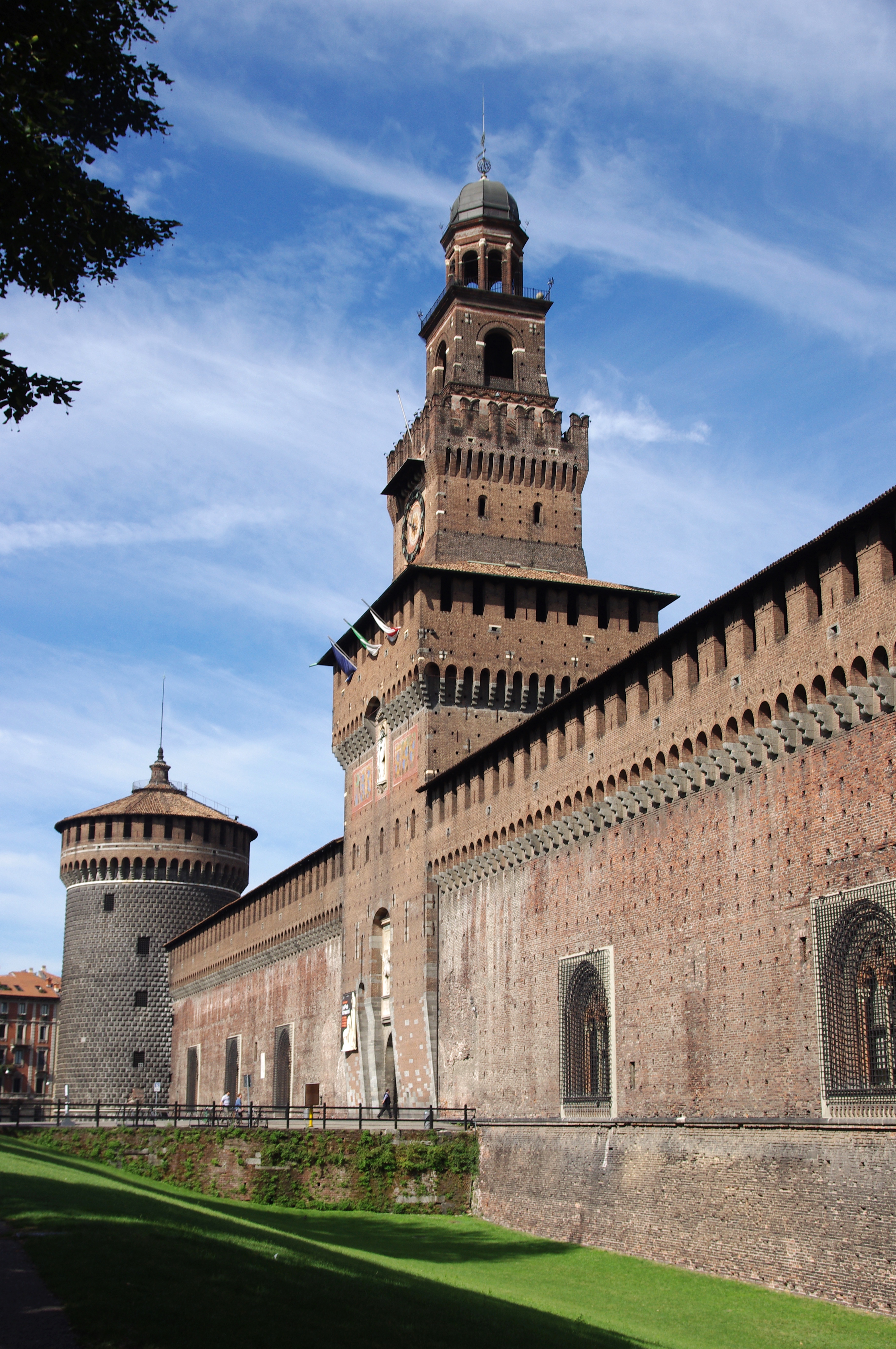
Castello Sforzesco
- Sempione Park is located north of the castle.
- Built in the 14th century and modified by later generations.
- Used as a residence by the Sforza family and decorated by artists such as Leonardo da Vinci.
- Features a square design with four corner towers and has suffered damage throughout history.
- Includes the Archaeological Museum, the Museum of Ancient Art, the Pinacoteca and more, with works by famous artists.
- Works attributed to Caravaggio and unpublished drawings by Leonardo da Vinci were found in the castle.

Palazzo dei Giureconsulti
- Palazzo dei Giureconsulti is a historic Mannerist-style palace in Milan.
- It was built in 1562 under the design of Vincenzo Seregni.
- In its history, it housed the Collegio dei Nobili Dottori and later the Borsa Valori and the Camera di Commercio.
- It was damaged by bombing in 1945 and underwent restorations in 1991, being renamed Palazzo Affari ai Giureconsulti.
- The palace has an area of 4000 m2 on four floors and various rooms for meetings and exhibitions.
Piazza Mercanti
- Created in the Middle Ages and later transformed into Via Mercanti.
- Surrounded by the Palazzo della Ragione, the Casa dei Panigarola and the Loggia degli Osii.
- Founded in the 13th century, originally wider with accesses to different districts.
- At the center of the square is a 16th-century well.
- Its sculptures include a Roman relief depicting the scrofa semilanuta and a statue of the podestà Oldrado da Tresseno.
- There are also monuments to the poet Decimus Magnus Ausonius and sant'Agostino.

San Sepolcro Church
- San Sepolcro Church is a Catholic place of worship, originally founded in 1030 and extensively modified over centuries.
- The building was originally named Santissima Trinità by its founder, Benedetto Ronzone, and was built on a Roman forum.
- In 1100, Archbishop Anselmo da Bovisio rededicated the church to the Holy Sepulchre of Jerusalem in honor of the Holy sites' significance during the Crusades.
- The design of the church, shaped like a cross by its founder, was altered to resemble the Anastasis in Jerusalem after the first Crusade.
- The church underwent numerous restorations, including changes to a Baroque style in 1605 by architect Aurelio Trezzi and a return to a Romanesque style in the late 19th century.
- In 1928, the church was acquired by the Ambrosian Library and lost its status as a parish, but it was used as a place of art exhibitions after being restored in 1968.
Day 2 - Afternoon à Milan
3 Points of interest - Duration : 2h00 - Distance : 0.6 km - Walking : 0h07Piazza degli Affari
- Seat of the Milan Stock Exchange, founded on January 16, 1808. site of Milan's Roman theater, built in the 1st century BC and destroyed in 1162. renovated with two majestic palaces, the Palazzo Mezzanotte and another, in 1930-1939.
- Maurizio Cattelan's "L.O.V.E." sculpture, with a hand cut off except for the middle finger, placed in the center of the square in 2010.

Piazza Cordusio
- It houses the headquarters of UniCredit and subsidiaries of Intesa Sanpaolo and Barclays.
- Palazzo Broggi was the headquarters of the Milan Stock Exchange between 1901 and 1932.
- The history of the square dates back to the Lombard era.
- It underwent changes in its design and buildings in the 19th and 20th centuries.
- The square appears in films such as "Gli uomini, che mascalzoni..." and "La corruzione.".
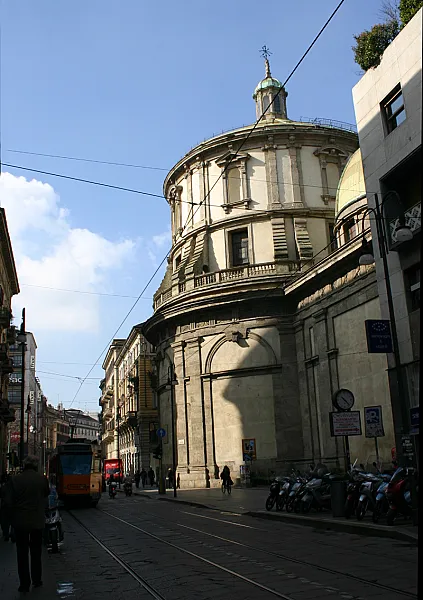
San Sebastiano
- The Tempio Civico di San Sebastiano was designed by Pellegrino Tibaldi (1527-1596) and started to be built in 1576.
- The church was erected by the governor of Milan, Antonio de Guzmán Zúñiga y Sotomayor in response to a devastating plague that had hit the city.
- The building was completed in 1616.
- It underwent administrative changes between the Curia and the governor's office, until it was entrusted to a municipal "conservatory" in 1861, primarily for artistic protection.
- The innovative project for Tempio Civico di San Sebastiano, developed by Tibaldi, considered the limited available space and scarce funds for construction.
- The design ended up being a perfectly cylindrical structure, a common feature in early Christian churches.
- The church houses a pipe organ, built in 1928 by Balbiani-Vegezzi Bossi, located within two intricately carved cases.
- The church has always had a fundamentally ambiguous, civilian and religious status, as it was a joint venture from the beginning of its construction.
Where to Stay in Milan
For a two-day stay in Milan, location matters more than anything else: you want to spend your time inside the ring of historic streets rather than fighting traffic. The centre is compact and pleasantly walkable, so choosing a base near the Duomo area lets you step out and reach the Galleria Vittorio Emanuele II, the Royal Palace of Milan and the theatres within minutes. Staying centrally means mornings for museums and afternoons for wandering charming streets, with evenings spent in one of Milan’s lively squares or quiet inner courtyards.
Understanding how the city is organized helps pick the right neighborhood. Milan’s heart is a cluster of distinct quarters radiating from the cathedral: elegant shopping avenues and grand arcades to the south, refined residential streets and museums to the east, and lively cafés and galleries to the north. Public transport — a dense network of metro lines, trams and buses — fans out from this core, so even if your room isn’t just off the piazza you can be there in ten minutes.
If your priority is immediate access to the Galleria Vittorio Emanuele II and the Royal Palace of Milan, aim for the Duomo/Centro Storico area where centuries of architecture sit side by side. If you prefer a slightly quieter, more atmospheric base with narrow streets, galleries and café culture, the Brera district sits a short stroll away and is perfect for afternoons spent exploring House Manzoni and nearby art attractions. For businesslike convenience with quick links to the stock exchange and historic banking quarter, the Cordusio/Piazza degli Affari area places you close to trams, metros and iconic façades.
Transport tips are simple and practical: choose lodging within a short walk of a metro station (lines M1, M3 cover the central spine) or a major tram stop so you can hop back to your room quickly between excursions. Taxis are plentiful but traffic can be slow; if you arrive by train, the central station gives excellent metro connections. If you stay a little farther out, opt for places with easy luggage storage and clear check-in instructions so your first and last day remain stress-free.
Finally, trust your comfort: for two days, a small boutique hotel, a family-run B&B or a serviced apartment near the centre will maximize sightseeing time. Look for rooms facing inner courtyards or quiet side streets for better sleep, and pick accommodation with flexible check-in when possible — that one thoughtful detail will make your short Milan stay calm, efficient and delightfully local.
Getting Around Milan
Milan’s public transport is surprisingly friendly for visitors — compact, frequent and easy to read once you know the basics. The heart of the city is served by an obvious network: the Metro lines link major sights, elegant surface trams glide through historic streets, and buses fill in the gaps. The operator, ATM, keeps signs clear and maps printable at stations, so even if Italian isn’t your strong suit you’ll find color-coded lines and station names that match your smartphone. I love how approachable it feels: on my first afternoon I hopped off the metro, followed the signs to the Galleria and instantly felt at home among the bustle. 🚇
Practicalities are simple. You can buy a single ticket from station machines, tabaccherie or the official app, and you must validate that ticket when you board or pass through turnstiles — in Milan the rule is to validate once and your ride is good for 90 minutes. If you plan several hops in a day, consider a 24/48/72-hour pass or the tourist MilanoCard which bundles transport with museum discounts; prices vary but a single ticket is roughly €2.20 and day passes often start around €7, so a quick math check often pays off. 🎫
Use Google Maps like a local guide: switch to the transit layer, pick your departure time and watch step-by-step directions that include platform names, walking times and scheduled departures. It will tell you whether it’s faster to walk from the Galleria Vittorio Emanuele II to your next stop or to wait two minutes for a tram. I always check live departures so I’m not standing on a windy corner — and Maps’ walking directions through Milan’s arcades are great for discovering shortcuts and arcaded streets you’d otherwise miss. 🗺️
Money-saving tip: if you’ll visit several museums and move around the center, a multi-day pass quickly pays for itself. Buy tickets in advance on the app to skip queues, validate every ride to avoid fines, and remember that many attractions — including the Royal Palace of Milan area — are close enough to combine walking with a single short ride. Small choices add up: a little planning saved us several euros and gave us more time to sip espresso instead of queuing.
Personal note: once, weary after a morning at the Duomo and Galleria, we wanted to reach the House Manzoni without dragging luggage. We scanned a digital single ticket on the ATM app, hopped on a tram that showed up in two minutes, validated on board with the little machine and enjoyed a scenic five-minute ride across the fashion district. It felt effortless — with a validated ticket, clear signs and Google Maps in my pocket, navigating Milan quickly becomes part of the fun. 💡
What to Pack for Milan
Two days in Milan is a sprint of churches, arcades, squares and cafés — I always treat it like a stylish city scavenger hunt. On my last short trip I was out for 10+ hours each day and walked about 12 miles (19 km) total, so I pack for comfort, pickpocket smart, and a little flair. Below are the essentials I actually use and why each one matters in real Milan situations.
1. Comfortable walking shoes (required — e.g., New Balance 574 or ECCO Soft 7): I learned this the hard way after a day from Duomo to Navigli where I walked 15 miles and regretted fashion heels instantly. Stiff soles and good cushioning saved my second day. Milan has cobblestones and long indoor arcades; breathable, supportive shoes keep you exploring all day.
2. Cross-body bag (zippered, worn in front): I carry a compact cross-body with a secure zipper and inner pocket — once I felt a hand on a crowded tram near Centrale, and having the bag worn in front prevented a pickpocket attempt. It’s hands-free for maps and espresso runs and the best way to protect phone, wallet and metro ticket in busy Galleria Vittorio Emanuele II.
3. Weather-appropriate clothing for Milan (light layers + a smart jacket): Milaners dress sharp but the weather shifts—during one spring visit mornings were cool and afternoons were sunny. I bring thin layers, a lightweight waterproof jacket, and a scarf. Layers mean you’re comfortable inside stylish cafés and outdoors in the square without looking out of place.
4. Power adapter (Type L for Italy, 230V): My phone and camera ran dead mid-afternoon on day one until I used a proper Italian adapter. Cafés don’t always have convenient sockets, so a small Type L adapter avoids hunting for a charger and keeps your devices ready for photo-heavy museum-free days.
5. Power bank (10,000 mAh+): I carried a 10,000 mAh power bank and topped up phones between stops — essential when you're out for 8–12 hours taking photos, using maps and checking tram times. Choose one that can fully recharge a smartphone at least once or twice.
6. Optional extras — compact umbrella & sunglasses: Milan’s weather can flip; a compact umbrella fits a small bag and saved me from a sudden shower. Sunglasses are a must for sunny piazzas and reflective shop windows. Both are small, practical additions that kept me comfortable and camera-ready.
Enjoy Your Trip to Milan !
In two energetic days you'll explore 14 carefully chosen spots across Milan, from the grand arcades of the Galleria Vittorio Emanuele II to the intimate House Manzoni and the stately Royal Palace of Milan. This itinerary is packed with historic architecture, vibrant squares, top museums and shopping moments—everything you need to taste Milan in a weekend.
Remember, this is a guide, not a strict schedule. Let it steer you, but leave room for the unexpected: the real magic often happens in unplanned moments—getting delightfully lost in Navigli lanes, stumbling on a tiny museum, or lingering over an espresso at a corner café. Don’t feel you must see EVERYTHING; slow down, savor, and follow curiosities with a relaxed heart.
I hope you feel excited and ready—I’m genuinely excited for you! Embrace the rhythm of Milan, from opera echoes at La Scala to sunlit piazzas, and let yourself collect unforgettable memories. You're going to love the small surprises as much as the big sights; enjoy every vibrant moment and the people you meet along the way.
Want to explore Milan in a playful way? Check out Coddy’s interactive tours—Secrets of Milan, Mates, and Mess and Madness MILAN—perfect for turning sightseeing into a gamified adventure. They’re a fun, relaxed way to discover hidden stories while you wander and playfully compete or collaborate.
Have an incredible two days—soak in the style, history, and espresso-fueled moments. If you want tips or want to share photos, ask me anytime. Enjoy! Safe travels!
Want more adventure?
Discover our urban escape games to transform your visit into an interactive adventure!















